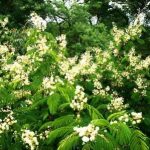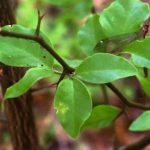TREE LIFE
August 2003
WHILE THE CURRENT FUEL CRISIS PERSISTS IT IS IMPORTANT TO CONFIRM WITH ANY OF THE COMMITTEE MEMBERS THAT THE SCHEDULED OUTINGS AND WALKS CAN ACTUALLY TAKE PLACE. SEE THE BACK PAGE FOR PHONE NUMBERS.
MASHONALAND CALENDAR
Saturday 2nd August. Botanic Garden Walk. We hope that in Tom’s absence Meg will step in to lead the walk. Meet in the car park at 10.45 for 11am.
August 8th to 13th. The Vumba trip.
Sunday 17th August. To Dombashawa where we will walk in a different area to those previously explored
Saturday 23rd August Mark’s Walk will be in the kopjes at Makumbi mission.
Saturday 6th September. Botanic Garden Walk.
MATABELELAND CALENDAR
Nothing has been arranged for August.
GWAAI FARM, MARONDERA: 15 JUNE 2003
Many people might have thought it was a bit foolhardy to attempt an outing to a farm c.140 kms from Harare in the middle of a severe fuel shortage. However, having actually found an at least partially functioning commercial farm, we could not resist the opportunity to visit it. In the end three cars made it there: two from Harare and one (John Bennett) from Mutare who came via Macheke on his way to Harare. In total there were eight people.
On arrival we had a very warm welcome from Phil Goodwin who had very kindly provided two cakes for us and also large amounts of tea.
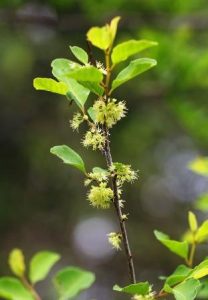
Flueggea virosa. Photo: Bart Wursten.
Source: Flora of Zimbabwe
Under the guidance of Phil we set off into some thin woodland not far from the farmhouse. From there, there was a magnificent view over a large tract of open grassland. We examined a termite mound; here was Flueggea virosa (the snowberry) and a very typical species of anthills, Euclea divinorum (the diamond-leaved euclea) with its characteristic undulate leaf margins.
Another typical species is Diospyros lycioides, the red star-apple. Species of diospyros are seen very commonly in Zimbabwe and some of them have an acrescent calyx, i.e. the calyx expands with age. Sometimes, as in this species, it forms a prominent star-shaped base to the fruit, in other cases (e.g. Diospyros whyteana) it encloses the whole fruit in a bladder-like structure. Diospyros lycioides is a common species in southern Africa, as the amount of black on the map in Coates Palgrave shows, but exhibits considerable variation over the range and has been divided into subspecies. Over most of Zimbabwe we have subsp. sericea and only in the south do we get a different subspecies, namely subsp. lycioides.
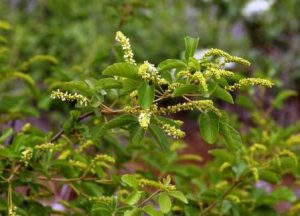
Allophylus africanus. Photo: Bart Wursten. Source: Flora of Zimbabwe
Also on the anthill were a number of common species, Erythrina abyssinica, the lucky bean tree, Ziziphus mucronata, (the buffalo-thorn), Allophylus africanus (African allophylus) and Rhus tenuinervis (the commiphora rhus).
Also present was a more unusual species which we only see when we come to the Marondera-Wedza area, namely Rhamnus staddo. This is typically a shrub rather than a tree and has small dark green leaves clustered at the ends of short branchlets. The flowers are tiny and the fruits consist of small red berries.
On next to another, somewhat taller, anthill. This had a more developed set of trees with underneath a larger area of shade and humus. Seen here were thorny specimens of Carissa edulis (the simple-spined carissa) and also Senna singueana (the winter-flowering senna), which we had seen flowering specimens of on the drive to the farm.
A slightly more uncommon species on this mound was Euclea racemosa subsp. schimperi. This has very glossy hairless leaves. In the woodland nearby was Heteropyxis dehniae, the lavender tree. This is an attractive and distinctive tree with many interesting spot-characters. Firstly, its family is Heteropyxidaceae or Myrtaceae (depending on the particular author’s opinion) and like most Myrtaceae it has translucent gland dots in the leaves. These glands produce the strong aromatic smell when crushed. Another feature is the distinctive, peeling, light-coloured bark. And, finally, the leaves have tufts of hairs in the axils of the leaves beneath (known as acaradomatia – the “houses of mites”) and these have corresponding domes on the upper surface of the leaf.
We then moved on into an adjacent game park. There was a dam at the side of which was an amazing house extending out into the lake. We scrambled up a small rocky hill. One shrub of interest was Myrsine africana; this has small leaves which have brownish-translucent gland dots. It is a somewhat local shrub, which we see occasionally in higher rainfall areas.
Amongst the large boulders at the top was a small Ficus natalensis with its rounded to truncate leaf apices and dark green leaves. I understand that a new name is proposed for this distinctive plant of rocky places. Also at the top, apart from a whole lot of elephant damage, there was a pinnate-leaved species which defeated me. Fortunately, Maureen recognised it – it was Fagaropsis angolensis. This is another higher rainfall species, which, like Rhamnus staddo becomes more frequent as you go eastwards from Harare. For the Tree Society, it is very much associated with the Marondera – Wedza area. It is easily recognized (ahem!) by its opposite compound leaves (Oleaceae and Bignoniaceae also have this) coupled with the gland dots. Also there was a tiny Pappea capensis, its leaves very sharply serrated.
After this, Phil took us round to a small thatched building at the edge of the dam. However, it was too cold and windy to sit there so we retreated into the woodland and ate a late lunch. Finally we drove back round a vlei and admired the large quantities of game (which included rhino). After some more cake and tea back at the farmhouse, we all headed for home.
I’d very much like to thank Phil for giving up a large part of his day to take us round the farm and game park. It was a wonderful, although I must add from the view point of a few days later, pepper-tick-ish, day!
-Mark Hyde
GIANTS OF THE STYX
According to my Collins English Dictionary the Styx belongs to the realm of Greek mythology, a river of Hades, across which Charon ferried the souls of the dead. The name comes from the Greek Stux, related to stugein, to hate.
According to E. Cobham Brewer (1906), Dictionary of Phrase and Fable, the Styx was the river of Hate, called by Milton “abhorrëd Styx, the flood of burning hate” (Paradise Lost, ii. 577). It was said to flow nine times round the infernal regions. The Styx is a river of Egypt, and the tale is that Isis collected the various parts of Osiris (murdered by Typhon) and buried them in secrecy on the banks of the Styx. The classic fables about the Styx are obviously of Egyptian origin. Charon, as Diodorus informs us, is an Egyptian word for a “ferryman”, and styx means hate.
Styx, the dread oath of gods.
“For by the black infernal Styx I swear
(That dreadful oath which binds the Thunderer)
‘Tis fixed!”
Pope: Thebais of Statius,i.
And now from the world of myth (Greek?, Egyptian?) to the mist-shrouded temperate rainforests of southern Tasmania’s Styx River Valley, named after the mysterious river of the underworld in ancient mythology. Here we visit the kings of the world’s hardwoods, the tallest flowering plants on earth. The oldest of these giant trees were growing there by the early 1600s-before the arrival of the first Dutch explorers. Today they stand over 90 metres tall, and are home to a variety of birds and tree-dwelling mammals, many of them unique to Tasmania. The relatively slow-flowing Styx River and its feeder creeks harbour the elusive duckbilled platypus. Among the trees, the ground-level hollows and the rotting logs provide refuge for the Tasmanian pandemelon, a small wallaby that has become extinct on the Australian mainland. The undergrowth is also a refuge for the larger Bennett’s wallaby, known on the mainland as the red-necked wallaby. The broken branches and hollow trunks of old trees provide havens for the smaller possum species, such as the brushtail, eastern pygmy, and little pygmy possums. Tree hollows also provide roosts for all eight bat species that live in Tasmania; and penthouse living in the upper crowns of the trees is claimed by the Tasmanian wedge-tailed eagle. Other creatures that make their homes among the old-growth trees are the (threatened) grey goshawk, and the spotted-tailed quoll, Australia’s second largest carnivorous marsupial.
The trees are mainly Eucalyptus regnans, known in Tasmania as swamp gum and in Victoria, on the Australian mainland, as mountain ash-can you possibly get two more disparate common names for the same tree species? The tallest of them all, today, stands at 92 metres, exceeded in height only by a 112.3-metre Californian redwood, Sequoia sempervirens, a conifer, but there are good reports of a 120-metre-tall mountain ash in Victoria that was felled in the 1870s. Also included among the giant trees is at least one specimen of Eucalyptus viminalis (manna gum) that tops 90 metres.
Giant trees like these have been cut down for more than a century, and the 20 000-hectare Styx Forest is a precious remnant of the vast tracts of swamp gum/mountain ash that once spread across both southern Tasmania and Victoria. Heavily mechanized methods of harvesting have increased in the region, producing more timber for veneer logs, sawlogs, and pulpwood, but creating fewer jobs to prop up the shrinking economies of once-thriving towns.
The Wilderness Society is leading conservationist campaigns for a 15 000-hectare national park in the Styx Valley. They claim that the logging of old-growth trees not only destroys a valuable heritage, but is extremely wasteful, with over 70 percent exported as woodchips for paper manufacture, and only about 2 percent being used as veneer, the highest-value timber product. woodchips, they argue, should come from plantation-grown trees, not from those more than 100 years old. This campaign is supported by a Federal Senator who was in the forefront of the successful 1983 battle to prevent the damming of Tasmania’s Franklin River, a World Heritage Site. The trees of the Styx Valley “are among the largest living things in the plant world”, he says. “To keep the Styx will give all future human beings a chance to experience this forest”.
(The main part of this note was adapted from an article by Helen Cushing, titled “Valley of the Giants”, which was published in Australian Geographic 64, Oct-Dec 2001.)
-Lyn Mullin
BOTANIC GARDEN WALK: 5 JULY 2003
Tom’s walk today covered the family Boraginaceae and specifically the two woody genera of that family which are present in Zimbabwe, namely Cordia and Ehretia. There is no doubt that there are taxonomic difficulties, especially with Ehretia, and it was a very welcome opportunity to hear Tom’s views.
The family Boraginaceae is a predominantly herbaceous family of 2300 species and 120 genera (per D.J. Mabberley, The Plant Book, 1997). The leaves are arranged alternately and are usually simple and entire; they sometimes have cystoliths or oxalate crystals which give them a very rough texture. The plants lack stipules. The flowers are usually regular and bisexual and are often arranged in cymes.
To begin with Cordia, we shall deal with each of the species which have been recorded in Zimbabwe.
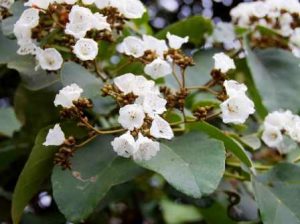
Cordia africana. Photo: Stefaan Dondeyne. Source: Flora of Zimbabwe
Cordia africana, formerly called Cordia abyssinica, is a very well-known plant from Harare gardens, although we don’t see it very often in the wild. It has largish leaves which are brown-hairy and are smooth above and slightly rough beneath. The flowers are quite spectacular and appear in large inflorescences all over the top of the crown.
In the wild, Tom mentioned that it is a pioneer in dry forest at low and medium altitudes, for example in the Rusitu valley, by the Pote River near Shamva and on Murahwa’s Hill in Mutare.
Cordia goetzei and C. mukuensis should probably be dealt with together. Both were known under C. goetzei before and both have a strongly fluted trunk bearing remains of the peeling bark revealing a smooth bluish or grey underbark. The trunk is a very distinctive feature indeed. The leaves of these species are smooth.
The difference is that C. goetzei has a longer petiole (1.3-3 cm) as opposed to mukuensis, the petiole of which is 0.5-1.5 cm long but note that there is an overlap in this range. The other difference is that goetzei has a broader leaf with the length up to 2 times as long as wide whereas in mukuensis the leaf length is more than 2 (sometimes up to 3 ) as long as wide. Both species occur on alluvial fans, especially in the Zambezi Valley.
Cordia grandicalyx is a species of the Matopos and the SE parts of Zimbabwe, for example the Tuli and Gwanda districts. The leaves are round in shape and are roughish but not very rough in the way that C. monoica is. The bark is smooth and grey.
Cordia monoica, formerly known as Cordia ovalis, has the roughest leaves of any Cordia and possibly of any species in the Zimbabwe flora. It is a strong competitor, for example with Ficus capreifolia. Apart from that distinctive feature it has a fluted, bluish and peeling bark, rather like the goetzei / mukuensis pair of species. The leaves are very broad and almost circular. This species is commonest at low altitudes in the S and E of Zimbabwe, but it does occur, though rather rarely, in the northern division – for example, we saw it on the outing to the Young’s Farm near Glendale.
*Cordia myxa is an exotic species, known as the Sudan teak or sebesten plum, which I believe is naturalized in the eastern districts. Again, we did not see this species.
Cordia pilosissima, like C. grandicalyx has circular leaves but, as the name suggests, these are densely hairy with long hairs. The leaves are smooth and the trunk is rough but not in any way fluted or angular. Unfortunately, the specimen in the Garden had died so we were not able to examine this species.
Cordia sinensis, formerly Cordia rothii, has a relatively narrow leaf and smooth, dark grey bark. It occurs in a very wide variety of habitats and at different altitudes but is nowhere common and is not very often seen.
Taxonomically, Cordia is relatively straightforward in Zimbabwe, apart, perhaps from the goetzei / mukuensis pair of species. However, Ehretia is a very different matter indeed. Before plunging in to the difficult area, let us look at two species which are relatively unambiguous, namely E. cymosa and E. rigida.
- cymosa is a large forest tree with large, broad smooth leaves and a short but noticeable drip tip. It also has a white slash, which changes to orange-yellow when exposed to the air. It is a rare pioneer species, recorded in Zimbabwe only from Chirinda Forest.
- rigida appears to be reasonably distinctive (but see the comment in the paragraph below). It has tiny very narrow leaves and a short petiole. These leaves are smooth above but very rough on the margin. This species occurs in the drier western parts of Zimbabwe, often on anthills.
Having said that E. rigida is always distinctive, it is important to mote that Martins in Flora Zambesiaca records that specimens intermediate between E. rigida and E. obtusifolia, possibly hybrids, have been recorded from Zimbabwe (for example at Gweru).
The difficult group encompasses three taxa: amoena, coerulea and obtusifolia. The account in Flora Zambesiaca recognises two of these, namely E. amoena and E. obtusifolia.
In that account, E. amoena is a white-flowered species. Technically, its corolla lobes are longer than the tube and are reflexed. This species occurs in riverine habitats at lower altitudes.
- obtusifolia has blue to mauve flowers and its corolla lobes are as long as or shorter than the tube and are spreading.
Tom mentioned that in the new Coates Palgrave, E. obtusifolia has been split into two, namely E. coerulea and E. obtusifolia sensu stricto. The distinction is, broadly, that E. coerulea has larger leaves and occurs on anthills.
-Mark Hyde
In Retrospect (Cont.) Lyn Mullin
THE BIG FROST OF 1968
In his Mukuvisi Woodland Notes in Tree Life No.127 (September 1990), George Hall touched on the part played by frost in localizing tree species. Then he went on to write:
Talking of frost and its effect: When we went to Chipoli in June we looked at a large Ekebergia capensis[dogplum] that may still be carrying scars of the big frost of 1968.
I have never read anything in print about this frost. The following evening the Meteorological Department provided some interesting details. I was in Bulawayo, and as the sun went down I `smelt’ frost coming, the way one does in northern Europe. The following day, as I watched my pawpaws (Carica papaya) buckle and sag to the ground, I realized that we had witnessed a unique phenomenon; I could not help but think of the story of those super-cooled air streams said to have frozen the elephants in Siberia.
We saw Acacia karroo [sweet thorn] and Acrocarpus fraxinifolius(Kenya coffee shade tree), up to ten metres high, killed stone dead.
Bulawayo saw burst water pipes from freezing water, but most of all I was sad for the sunbirds, which had lost all flowering material for days after the big freeze.
I am sure there are among our readers some who retain anecdotes and information about this big frost, and its effects on vegetation, etc. I would be happy to hear from you. I would be equally happy to be told of anything in the literature. Apart from Trees of Southern Africa (Coates Palgrave) and the exploding baobabs, I have seen nothing. If any reader can contribute, I would like to hear from you.
[Comment 2000: No one seems to have responded to George Hall’s appeal for more information on the big frost of June 1968, which is surprising, because there was a paper by PF Banks in The Rhodesia Science News of April 1969 (Vol.3 No.4) titled “Observations on the June 1968 Frosts and Their Effect on Plantations and Trial Plots of Exotic Trees in Rhodesia”, and one of the references cited in this work was a paper by JB Hattle that appeared in the Rhodesia Farmer, Vol.XXXIX, No.10 (1968) under the title “The Big Freeze”. Banks’s paper would be of limited interest to members of the Tree Society because it deals with exotic plantation trees – commercial and under trial – but it might be of some interest to learn of severe damage to wattle (Acacia mearnsii) up to 18 m tall in the Nyanga district, where temperatures as low as -13 degrees C were recorded by the Met Department. There were also cases of individual specimens of Eucalyptus grandis, 30 m tall, that were frosted right to the growing tip, and some species of pine, up to then regarded as frost hardy, were also damaged.To quote from Banks’s paper: “Zimbabwe experiences only `radiation’ frosts as distinct from `advective’ frosts, which are caused directly by the influx of sub-zero air. The development of radiation frosts requires cold dry air, clear skies, and calm conditions. Exceptionally dry air entered the country in June 1968 [13th, 14th, 15th, and 16th] and…the dryness of this air mass, rather than its coldness, was mainly responsible for the ensuing frosts.
During the evening the ground surface loses heat, and cools the air in contact with it. The continuation of this process throughout the night can result in very low temperatures at or near ground level. But temperatures at higher levels are not affected. The resulting inversion of temperature is characteristic of radiation frost conditions.
Wind tends to mix the colder surface air with the warmer air above, thus preventing the temperature from reaching very low values. Relatively calm conditions are therefore essential for severe radiation frosts to occur.
It is generally accepted that when plant tissue is frozen it contracts, this contraction being greatest on the outside, and resulting in pressure being exerted on the delicate growing inner cells, which are compressed and deformed. In addition, and unless the rate of freezing is extremely rapid, ice crystal formation tends to occur in the intercellular spaces of the external tissues, and this has a dehydrating effect on the actively growing cells”.
[Comment 2000: Some interesting observations were made on the effects of the 1968 frost on the indigenous vegetation of the Nyamukwarara Valley, some 40 km (straight-line distance) northeast of Mutare. This valley is only 700 m above sea level at its lowest (within Zimbabwe), but altitudes rise up to 1 800 m above sea level on its eastern and western slopes. Cold air drains into this valley every night during the winter months, and ground minimum temperatures of up to -6 degrees C were commonly recorded at a small met station set up in 1969 in the bottom of the valley. Although more than 30 years have elapsed since the big frost, it was such a remarkable phenomenon that the memory of it is still fresh. There is no way of telling what the ground minimum temperatures actually were during the 1968 frost, but it would be reasonable to believe they could have been down to at least -13 degrees C. This was a black frost, and there was no sign anywhere of the white hoar-frost that is familiar to everyone. Much of the valley was dominated by Brachystegia spiciformis (msasa) and B. utilis, with a wide range of miombo woodland species, plus Breonadia salicina (muwonya) and Khaya anthotheca(red mahogany) along the streams, scattered Pericopsis angolensis (muwanga) and Pterocarpus angolensis(mukwa) on the slopes, and widespread Mucuna coriacea (buffalo bean) and Oxytenanthera abyssinica(bamboo). Apart from Pittosporum viridiflorum, which stood out as the only bit of visible green, everything else below an altitude of 1 000 m was savaged and blackened by the frost, and the frost line (marking the upper limit of the frosted area) remained visible into November of that year.Few trees were killed, but many of the herbs and shrubs were.
To be continued.
THE ENIGMATIC AND ELUSIVE GILES’ MALLEE
What on earth is a mallee? Mallee is an Australian term for the growth form of many eucalypts that are multi-stemmed from ground level, usually no more than 1-10 m tall, often with the crown predominantly at the ends of the branchlets, and individual plants may combine to form either an open or a closed formation. The mallee form is adopted by many eucalypts as a strategy against fire, and the bulk of the plant’s biomass is usually below ground level in the form of an enormous lignotuber.
For 115 years Giles’ mallee (Eucalyptus rameliana) was known only from a few leaves, flowers, and a bud collected in 1876 by Australian explorer Ernest Giles on his fifth, and final, expedition across the Western Australian deserts. The specimens were handed to the Government botanist in the State of Victoria, Baron Ferdinand von Mueller, who recognized the species as new to science, and named it in honour of Prospero Ramel, who had introduced eucalypts into southern France and Algeria. To this day nothing else is known about Ramel, and he remains as mysterious as he did, for so long, the plant named for him. Until its re-discovery in 1991, E. rameliana was the only species, among more than 750 in the genus, that was presumed to have become extinct.
What originally marked Giles’ mallee as different from all other desert eucalypts were its large, smooth, solitary buds on long stalks. Today, it is one of only 3-4 species of Eucalyptus that have solitary flowers and fruits; one of these, E. globulus (Tasmanian bluegum), is present in Zimbabwe in the Nyanga National Park, with a notable stand directly in front the Rhodes Hotel. All eucalypts flowers are borne in odd numbers-1, 3, 5, 7, 9, 11, 13, 15 or more (the commonest number seems to be 7)-and where even numbers are found it is always the result of the abortion of one or more buds.
The precise location of Giles’ original collection of E. rameliana was never properly recorded; it was simply said to be “beyond the Alfred and Marie Range”, and efforts to find the species again were frustrated for so long for this very reason. Although he had diligently recorded landscape and vegetation on his expedition, Giles had made no reference to the handsome-flowered and large-leaved mallee that he had collected. A number of unsuccessful expeditions were mounted in the 1980s to find the plant, and Richard Seward, an old friend and colleague of mine (and a member of the Tree Society of Zimbabwe), who participated in a seed-collecting mission in central Australia in 1983, was involved in keeping a mild eye open for it.
In July 1991 the species was finally tracked down 500 km beyond the Alfred and Marie Range, and good-quality herbarium material was collected, including mature fruits, which had been lacking in Giles’ original collection. Subsequent searches have located additional populations of the species, one of them close to the presumed path of Giles’ 1876 expedition. Giles’ mallee today is known only from red desert dune country around latitude 25S and 120E.
-Lyn Mullin
(With acknowledgements to an article by Steve Hopper in Landscope This was available only as a photocopy with no indication of date or issue number.)
PEPPER TICKS
Ticks and mites belong to the order Acarina (or Acari). All ticks suck blood for part of their lives; some are not fussy about their choice of host, while others are much more specific and may only be found on one kind or group of animal. The mouthparts of ticks are somewhat different from those of the Arachnida: instead of a true head, the ticks have a ‘capitulum’, or gnathosma, consisting of a basal portion to which the piercing hypostome, the cutting chelicerae, and the palps are attached. The tips of the chelicerae have sharp digits, used to lacerate the skin and facilitate the entry of the hypostome which is then anchored by its rows of backward projecting spines.
Ticks lay large numbers of eggs which hatch into 6 legged larvae. These are the pepper ticks. After their first blood meal they moult into 8 legged nymphs, then feed again and moult into adults, also with 8 legs. The fat grey engorged ticks are fully fed females, males of the same species are reddish brown ticks.
African tick bite fever results from infection with Rickettsia conori. This is transmitted trans-ovarially from an infected female to all her eggs. The bite of the infected tick becomes swollen and tender, with a characteristic black crater in the centre. There is a high fever and a splitting headache and often a rash. Immunity from further infection occurs afterwards.
-Adele Hamilton Ritchie
from: S.H. Skaife 1979 African Insect Life, Cape Town, Struik
ROOTNOTE
Tea Tree oil which is obtained from Melaleuca alternifolia has been found to help with the itch caused by pepper tick bites.
The oil is said to be effective against bacteria, fungi and viruses.


